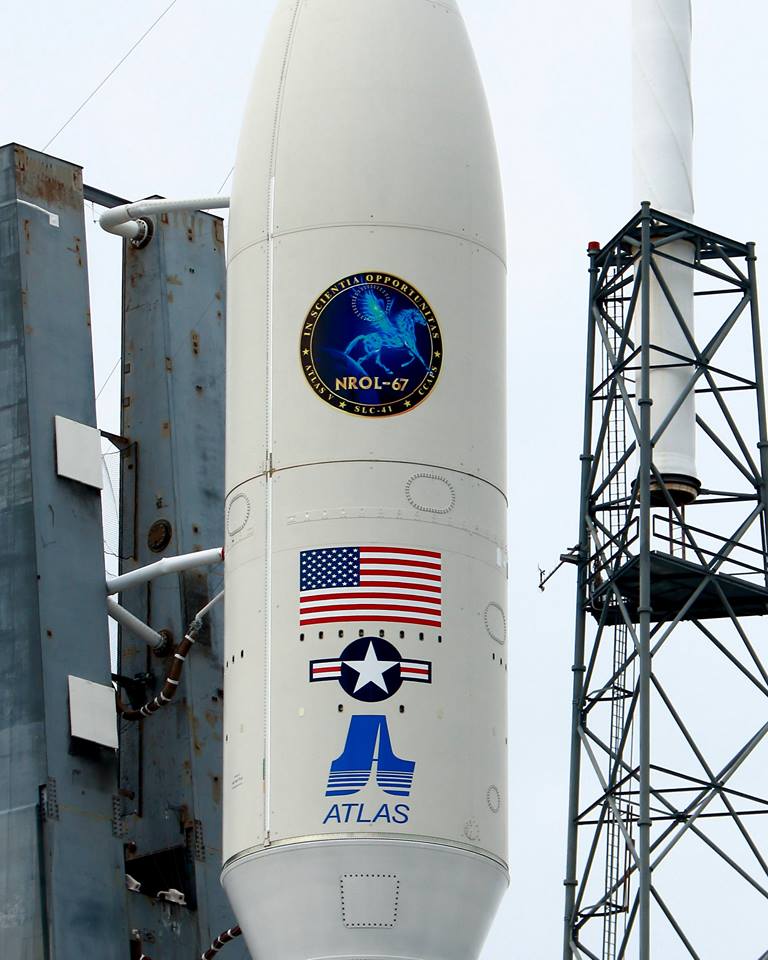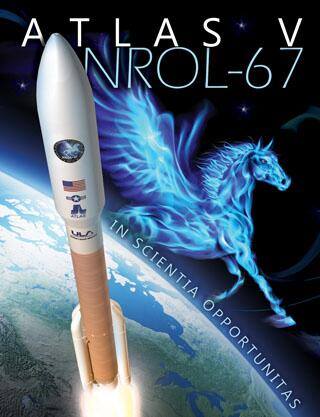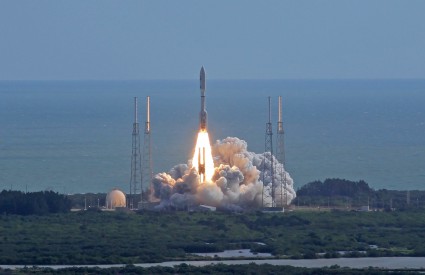
More than two weeks later than planned, the Eastern Range is primed to support two launches from Space Launch Complexes (SLC)-40 and 41 at Cape Canaveral Air Force Station, Fla., in the next few days, the first wholly shrouded in secrecy and the second a highly visible commercial cargo delivery flight to the International Space Station (ISS). Originally slated to fly in mid-March from SLC-40, SpaceX’s third Dragon mission—designated “CRS-3” or “SpX-3″—was postponed until the end of the month, then pushed into mid-April, following a fire which impacted an Eastern Range radar tracking asset. Also affected was United Launch Alliance’s (ULA) Atlas V mission from SLC-41, carrying the classified NROL-67 payload for the National Reconnaissance Office. The radar issue has since been resolved, and ULA is pressing ahead with plans to launch NROL-67 on Thursday, 10 April, with SpaceX scheduled to launch Dragon atop its Falcon 9 v1.1 rocket on Monday, 14 April.
According to ULA, the Atlas V will fly during a 41-minute “window,” which extends from 1:45 p.m. until 2:26 p.m. EDT Thursday. The NROL-67 mission was originally planned for launch on 25 March, but was postponed by 24 hours, then another 24 hours, when the 45th Space Wing experienced what it described as “an issue with a mandatory range asset.” The nature of the issue, and recognition of the fact that it would require around three weeks to fix, prompted an announcement that the Atlas V would remain on the ground until at least 10 April. ULA reported that the 19-story rocket had been transferred from the SLC-41 launch complex to the Vertical Integration Facility (VIF) and that both the vehicle itself and the classified NROL-67 payload had been secured.
Present estimates predict a 90-percent likelihood of acceptable weather conditions for tomorrow’s launch, with Patrick Air Force Base meteorologists highlighting “thick cloud” as one of the primary concerns. It was stressed that a cold front would bring cloudy skies, gusty south-westerly winds, and showers, together with isolated thunderstorms, but that by the time of the NROL-67 opening launch attempt on Thursday the areas of high pressure would begin to move eastward, leaving mostly sunny skies, dry conditions, and easterly winds over the Cape Canaveral area. Winds are expected to be within limits early Thursday morning for the planned rollout of the Atlas V stack, atop its Mobile Launch Platform (MLP), from the VIF to SLC-41. The vehicle should be “hard down” on the pad about 7.5 hours ahead of the opening of the launch window, after which engineers will set to work establishing electrical and fluid connections and performing flight control system checks and weather briefings.

The Atlas V, which has staged 44 civilian and military missions from both the Cape and from Vandenberg Air Force Base, Calif., since its maiden voyage in August 2002, will fly in its second most powerful variant to deliver NROL-67 into orbit. The so-called “541” configuration of the vehicle consists of a 17.7-foot-diameter (5.4-meter) payload fairing, together with four strap-on solid-fueled boosters and a single-engine Centaur upper stage. With the potential to loft payloads weighing up to 38,455 pounds (17,443 kg) into low-Earth orbit, and up to 18,276 pounds (8,290 kg) into geostationary transfer orbit, the Atlas V 541 has previously been used only once: In November 2011, it boosted NASA’s Mars Science Laboratory (MSL) and the Curiosity rover on a journey to the Red Planet.
The Atlas V has one of the most reliable track records of any operational launch vehicle in the world today, having flown its 43rd outright successful mission just a few days ago, from Vandenberg Air Force Base, on 3 April, to deliver the Defense Meteorological Satellite Program (DMSP)-19 military weather satellite into orbit. In a long string of launches, which forms a central tenet of ULA’s philosophy of “Perfect Product Delivery,” the Atlas V has suffered just one partial failure: a premature shutdown of its Centaur upper stage in June 2007, which left a pair of ocean surveillance satellites in a lower-than-planned orbit.
Stacking operations associated with the Atlas V 541 began on 7 February in the VIF and were completed in mid-March with the installation of NROL-67 atop its Centaur upper stage. Following the three-week stand-down, caused by the range radar issue, the booster should be delivered to SLC-41 early Thursday. At T-2 hours, a 30-minute built-in hold in the countdown will begin, ahead of the loading of cryogenic propellants aboard the Common Core Booster (CCB) and the Centaur. Liquid oxygen will be transferred into the tanks of the Centaur and should reach flight levels and enter a topping-off mode to replenish the effects of cryogenic boil-off by about T-64 minutes. Meanwhile, the three-stage operation of fueling the CCB with liquid oxygen and a highly refined form of rocket-grade kerosene (known as “RP-1”) will get underway, proceeding through Slow Fill, Fast Fill, and Topping modes. The last propellant to be loaded will be liquid hydrogen into the Centaur, which should reach its Topping level by T-39 minutes.
With all tanks confirmed at flight levels, the final checkout of the Flight Termination System (FTS) will be performed and the ascent software, based upon the real-time weather situation on the Florida coast, will be updated. Four minutes before launch, following a “Go-No Go” poll of all stations, the terminal countdown will commence. The vehicle will be transitioned to internal power, and, 60 seconds ahead of liftoff, the Launch Control System will be enabled and the Atlas’ computers will assume primary command of all critical functions. Two and a half seconds before liftoff, the rocket’s Russian-built RD-180 first stage engine—fueled by liquid oxygen and RP-1—will roar to life, spooling up to its full 860,000 pounds (390,000 kg) of thrust by T-0. Climb-out of the stack from SLC-41 will get underway at T+1.1 seconds.

Shortly after clearing the tower, the vehicle will execute a combined pitch, roll, and yaw program maneuver to position it onto the proper flight azimuth for the injection of NROL-67 into orbit. A little over a minute into the flight, with the RD-180 still burning hot and hard, the rocket will burst through the sound barrier, at which point maximum aerodynamic stresses (known as “Max Q”) will be experienced through the Atlas’ airframe. In response to this aerodynamic situation, the RD-180 will be temporarily throttled back to 95 percent of its rated performance. It will finally shut down about four minutes and 22 seconds after launch, and, following the separation of the first stage, the turn will come for the Centaur, which carries the key responsibility of boosting NROL-67 into orbit. The Centaur’s RL-10A engine, built by Pratt & Whitney, is capable of restarting in flight, although the number of “burns” it will perform to deliver its classified payload remains unknown.
Want to keep up-to-date with all things space? Be sure to “Like” AmericaSpace on Facebook and follow us on Twitter: @AmericaSpace
Missions » NROL » NROL-67 »


